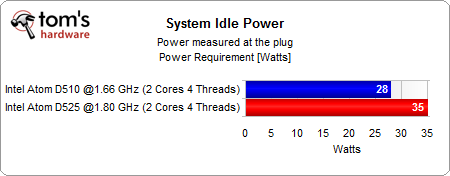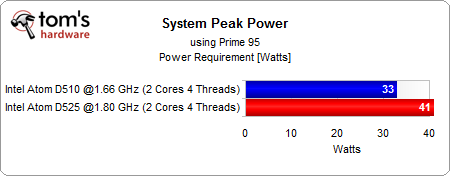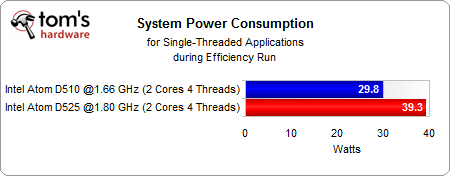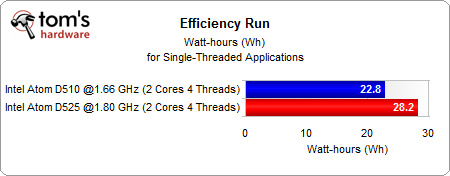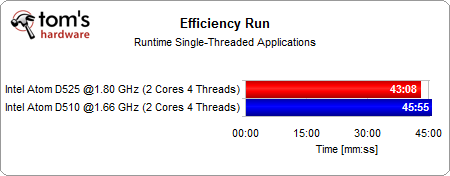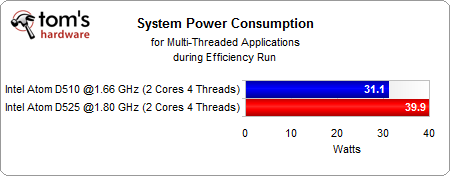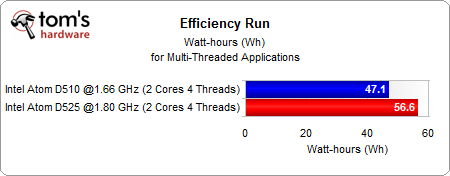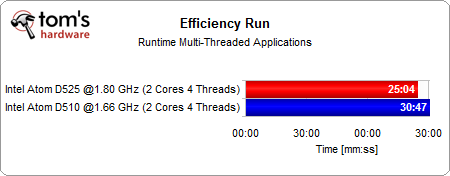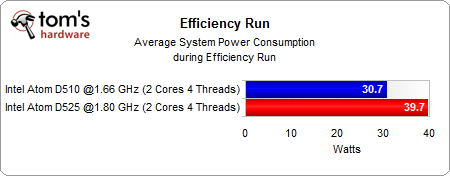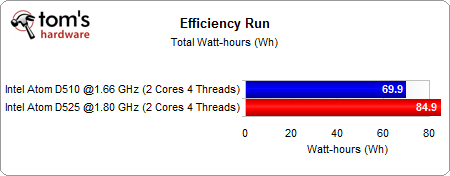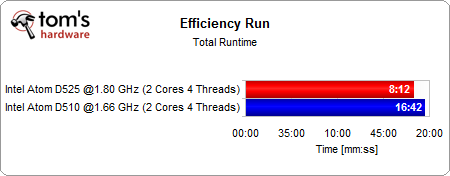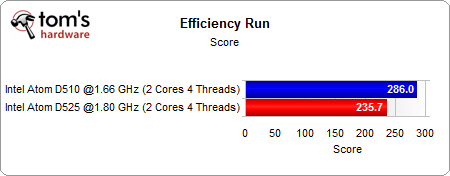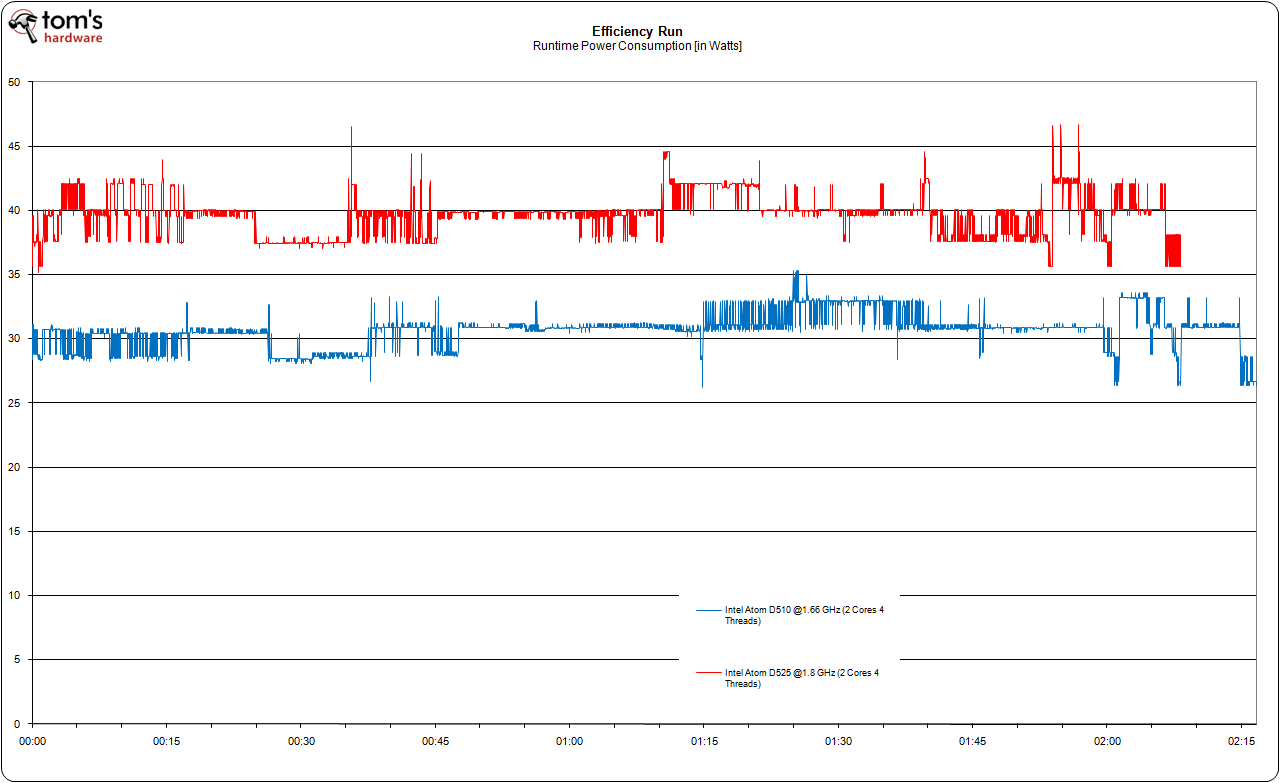Efficiency Analysis: Atom D510 Vs. Atom D525/ION2
Intel's Atom D525 offers a faster clock rate than its predecessor at the same 13 W TDP. Obviously, the new dual-core chip is going to be faster. But after we determined that the Core i3 is more efficient, can Atom D525 usurp the desktop contender?
Round 4: Power Consumption And Efficiency
Power Consumption
We typically look at the two most extreme conditions for power requirements: idle operation and peak load. It turns out that the power consumption difference of the two test platforms is significantly different, mostly because of the additional Nvidia ION2 graphics on Jetway's motherboard.
Adding 7 W more idle power consumption doesn't seem like a lot, but it makes quite a difference in low-power scenarios. The difference under peak load (CPU-only) is roughly 8 W, showing that the additional power draw is always there and that the faster Atom seems to be consuming slightly more power than the older Atom D510.
Thus, the peak power consumption of the Atom D525 system seems to be roughly 1 W higher than the D510 machine. This could be within the range of error of our test equipment, so we'll call it a draw. Intel's claim of delivering more performance at the same thermal envelope seems valid.
Efficiency Comparison
Still, we'd like to compare the two test systems more holistically. In this light, the overall result is different because of the ION2 graphics unit on the Jetway NC98-525-LF. The platform consumes more power, which has a negative impact on efficiency. At the same time, the additional power consumption might be worthwhile, considering that you can easily play high-definition video content. We'll discuss this in the conclusion.
Single-Threaded Efficiency
Get Tom's Hardware's best news and in-depth reviews, straight to your inbox.
The power required for our single-threaded workload is higher on the Atom D525 system because of its added ION2 graphics unit.
Multi-Threaded Efficiency
This also applies to the multi-threaded test.
Efficiency Summary
Finally, our total efficiency test reveals that Intel's Atom D510 platform is more efficient than the newer Atom D525 platform from Jetway. This doesn't help to compare efficiency between the two Atom generations, but it shows us that the system with ION2 graphics is less efficient and delivers less performance per watt in standard application workloads.
Efficiency Diagram
This is a summary of the full efficiency workload. As you can clearly see, power consumption is quite a bit higher on the Atom D525-based solution for the reasons mentioned above. Power consumption should actually be very comparable between the two, with the Atom D525 delivering better performance that leads to a faster completion of the workload. Looking at the approximately 1 W difference we extrapolated, it's pretty safe to say that performance per watt does not change much on the new Atom D525.
Current page: Round 4: Power Consumption And Efficiency
Prev Page Round 3: Audio And Video Benchmarks Next Page Ringing The Bell: Conclusion
Igor Wallossek wrote a wide variety of hardware articles for Tom's Hardware, with a strong focus on technical analysis and in-depth reviews. His contributions have spanned a broad spectrum of PC components, including GPUs, CPUs, workstations, and PC builds. His insightful articles provide readers with detailed knowledge to make informed decisions in the ever-evolving tech landscape
-
darthvidor very nice, thank you. been wondering how fast and energy efficient the new atom is. might replace the intel d945gclf2 connected to my tv.Reply -
Scanlia Thanks... now I know that a D525 is better than the D510... I thought a higher number means that it's slower... .Reply -
Gin Fushicho I just skipped to the power consumption after I saw the application benches.Reply
I'd rather keep the D510 over a D525. Longer battery life for my simple purpose of web browsing. -
super_tycoon i don't think you guys even tried using the d525/ion2 system for anything beyond the benchmarks. you greatly underestimate how usable it is. my asus 1215n chugs along just fine in almost any game. obviously you wouldn't want to throw something like civ5 at it, but in reality the combo plays games better than (for the most part) any iX notebook with integrated graphics. it plays company of heroes and starcraft 2 just fine at lowered settings. i'd bet you'd be surprised how viable it is as a light gaming platform for something that uses as much power as your monitor.Reply -
jeremypv >>This could not be done without Nvidia's graphics unit, as even 720p video was impossible to watch on the Atom D510.Reply
I'm using xbmc with a D510, and it plays 720p video just fine, with coreavc, it can even play a few 1080p videos -
ta152h Was this supposed to be about the Ion, or the D525? Why would you write an article with the intent to compare two processors, and put them on very different platforms?Reply
I didn't even read this worthless article after I saw that. It would have been interesting had the reviewers used some common sense. -
JonnyDough Except for power savings...why would anyone buy one of these when you can get recycled PCs for almost free? In six months they will have something a lot better anyway.Reply -
SteelCity1981 I don't get why intel still hasn't made the transition to 32nm for the Atoms yet. You would think these chips would have been the first to get 32nm.Reply
